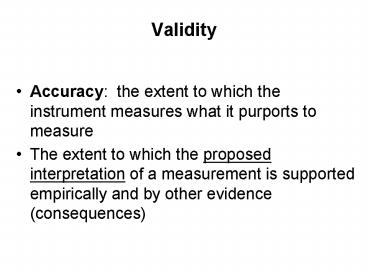Validity - PowerPoint PPT Presentation
1 / 15
Title:
Validity
Description:
The same measure may have many validities depending on intended uses ... For published instruments have sources where additional information can be found been cited? ... – PowerPoint PPT presentation
Number of Views:56
Avg rating:3.0/5.0
Title: Validity
1
Validity
- Accuracy the extent to which the instrument
measures what it purports to measure - The extent to which the proposed interpretation
of a measurement is supported empirically and by
other evidence (consequences)
2
Types of Validity
- Content Validity
- Construct Validity
- Concurrent Validity
- Predictive Validity
3
Content Validity
- When a test is used to assess prior learning
- Does the measuring instrument (test,
questionnaire, inventory) cover the domain of
material (content) that it is supposed to cover? - Does the test cover a representative sample of
the behavior domain (skills, process) to be
measured? - Can the test performance be considered free of
irrelevant factors?
4
Assessing Content Validity
- Define the domain of content and processes
- Conduct a logical analysis of the domain
- Select a pool of items with proper statistical
characteristics to represent the concepts in the
domain
5
Construct Validity
- When purpose is to validate a theory or assess a
human (psychological) trait (constructs inferred
from unobservable) - Concern is with the constructs embedded in the
measure (does the instrument measure the
psychological trait(s) it is supposed to measure) - Focus on scientific inquiry (theory
building)understanding the psychological
constructs that account for human behavior,
performance
6
Assessing Construct Validity of a Measuring
Instrument
- Operationally define the construct
- Specify relationships with other constructs
- Process correlate measures with other measures
(-1.00 to 1.00) - Convergent and discriminant validation
- Tests/Items that measure different trait should
not correlate with each other - Tests/Items that measure same trait should
correlate with each other
7
Concurrent Validity
- Validating a newly developed measure
- Simultaneously administer new measure with an
accepted measure of the same construct - Examine correlation coefficient (validity
coefficient) between the measures - Concurrent validity coefficient the correlation
between a given measure and some criterion
performance (-1.00 to 1.00)
8
Predictive Validity
- To predict performance or behavior
- To select/place people into a program, position,
task - To develop short test Test-substitution
- Predictive validity coefficient the correlation
between a given measure and some criterion
performance (-1.00 to 1.00)
9
All Validity Questions Resolve Into Questions of
Construct Validity
Conceptual Framework Content Face
Validity Representativeness Criterion Predictive C
oncurrent Consequential
CONSTRUCT VALIDITY
10
Warnings about Validity
- Interpretations, not measures (e.g., tests) are
validated - The same measure may have many validities
depending on intended uses - Validation is a process, not an end result
- Validity coefficients are only estimates (a
matter of degree)
11
Relation of Validity to Reliability
- Reliability is a necessary but not sufficient
condition of validity. - If a test does not measure whatever it measures
consistently then it cannot be valid for any
purpose - A test may measure with high degree of
reliability, with no validity (usefulness for
purpose for which it is intended) - A valid test is reliable
12
General Warnings about Reliability and Validity
- Data quality by itself does not determine the
degree to which results can be trusted - Beware of unjustified claims
- Validity and reliability are characteristics of
the data produced by measuring instrument, not of
the instrument itself - Validity and reliability coefficients are only
estimates - Both subject to same warnings about correlation
13
Evaluating Instruments
- Have actual questions and/or directions been
provided? - Are special formats, settings and/or restrictions
described? - When appropriate are multiple methods used?
- For published instruments have sources where
additional information can be found been cited?
14
Evaluating Instruments (Cont)
- If measuring sensitive matters is there reason to
believe accurate data were obtained? - Does the instrumentation obtrude on or change any
behaviors that were observed? - If collection and coding of data is highly
subjective is there evidence that a similar
result would be obtained if another researcher
measured the same group, at the same time, with
the same measure? - If instrument is designed to measure a unitary
trait, does it have adequate internal consistency?
15
Evaluating Instruments (Cont)
- For stable traits, is there evidence of temporal
stability? - When appropriate is there evidence of content
validity? - When appropriate is there evidence of empirical
validity? - Is instrument adequate in light of the research
purpose?































